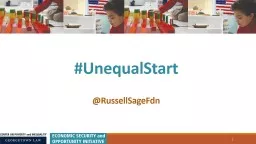PPT-1 # UnequalStart @ RussellSageFdn
Author : tatyana-admore | Published Date : 2018-03-08
Cradle to Kindergarten A New Plan to Promote All Childrens Development Ajay Chaudry Taryn Morrissey Christina Weiland and Hirokazu Yoshikawa BRIEFING April 24 2017
Presentation Embed Code
Download Presentation
Download Presentation The PPT/PDF document "1 # UnequalStart @ RussellSageFdn" is the property of its rightful owner. Permission is granted to download and print the materials on this website for personal, non-commercial use only, and to display it on your personal computer provided you do not modify the materials and that you retain all copyright notices contained in the materials. By downloading content from our website, you accept the terms of this agreement.
1 # UnequalStart @ RussellSageFdn: Transcript
Cradle to Kindergarten A New Plan to Promote All Childrens Development Ajay Chaudry Taryn Morrissey Christina Weiland and Hirokazu Yoshikawa BRIEFING April 24 2017 Georgetown Center on Poverty and inequality amp US Senate HELP and Finance Committees.
Download Document
Here is the link to download the presentation.
"1 # UnequalStart @ RussellSageFdn"The content belongs to its owner. You may download and print it for personal use, without modification, and keep all copyright notices. By downloading, you agree to these terms.
Related Documents

